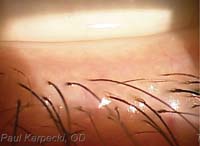 I’ve noticed in my pre-fit assessment of potential contact lens patients that some occasionally show general signs of Demodex infestation, especially patients over 50. Which of these patients pose a problem, if not treated? And, if you choose to treat, what do you recommend using prior to wearing lenses?
I’ve noticed in my pre-fit assessment of potential contact lens patients that some occasionally show general signs of Demodex infestation, especially patients over 50. Which of these patients pose a problem, if not treated? And, if you choose to treat, what do you recommend using prior to wearing lenses?
Demodex is a species of intradermal parasitic mites that reside in the ducts of the sebaceous glands that are near or connected to hair follicles in humans and animals.1 Incidents of Demodex infestations often are linked to blepharitis and rosacea, and increase with age, making patients older than 50 a high-risk group.
 |
|
Common Demodex treatment options include eyelid scrubs and tea tree oil wipes.
|
These mites have the capability of inciting severe inflammation of the meibomian glands and the eyelid margins, according to Dr. Azari. This can lead to complications such as meibomian gland dysfunction and tear film disruption.
“These disorders can cause dry eye, conjunctival inflammation and even corneal scarring,” adds Dr. Azari.
In addition to these complications, these mites exhibit symptoms similar to those of ocular allergies, according to Milton Hom, OD, who practices in California.
“As a result, we now always look for Demodex in contact lens patients who report allergy symptoms,” says Dr. Hom.
Swiftly treating any contact lens patients presenting with a Demodex infestation will greatly improve lens comfort, according to Scott Schachter, OD, of Advanced Eyecare in Pismo Beach, Calif.
“Because contact lens use can also exacerbate dry eye, patients suspected of having Demodex blepharitis may benefit from treatment prior to contact lens wear,” says Dr. Azari.
There are a number of available treatment options for this condition, and your choice should be dependent upon the severity of the presentation.
“I manage mild cases of the condition with tea tree oil wipes (Cliradex) twice per day for a month, then re-evaluate the patient,” says Dr. Schachter.
According to Dr. Azari, Cliradex eyelid scrubs contain 4-terpineol, which is the effective ingredient in tea tree oil, for reducing the population of the Demodex species.
“For moderate-to-severe cases, a combination of a once-a-week in-office application of 50% tea tree oil and daily lid scrubs with 5% tea tree shampoo at home has also been advocated,” says Dr. Azari. “All of these treatments should continue for several weeks until all of the signs and symptoms have resolved.”
According to Dr. Schachter, it’s also important to always evaluate the family members of a patient presenting with Demodex infestation, as the mites can be spread by direct contact between individuals. All make-up should be discarded, and any linens should be immediately washed and then dried on a high-heat setting.
“Demodex is a ubiquitous mite that is also found on many normal patients,” says Dr. Schachter. “I tell patients that if we see any signs of blepharitis, they likely have too many, and we need to reduce the population.”
1. Czepita D, et al. Demodex folliculorum and Demodex brevis as a cause of chronic marginal blepharitis. Ann Acad Med Stetin. 2007;53(1):63-7.

